Recent news:
WASHINGTON, DC — James von Brunn, the white supremacist who allegedly opened fire Wednesday at the U.S. Holocaust Memorial Museum in Washington, D.C., suggest that a lifetime of hatred had reached a critical mass. The 88-year-old is charged with murdering a security guard at the building.
LITTLE ROCK, Ark. — A Muslim convert charged with fatally shooting an American soldier at a military recruiting center said Tuesday that he doesn’t consider the killing a murder because U.S. military action in the Middle East made the killing justified.
NBC News is reporting that at Camp Liberty, the main U.S. military base in Iraq, which is located near the Baghdad International Airport, a yet unnamed serviceman walked into a “stress clinic” in the camp, opened first, killing at least five. Contrary to earlier reports, the soldier did not kill himself but is now in custody.
When things like this happen, we all stop and ask what went wrong? In two of the three situations, we had relatives or friends nearby. My daughter-in-law’s friend was working at the museum, and my son-in-law is stationed beside the stress clinic at Camp Liberty.
I’ll never forget when the Reagan administration began the movement to close down mental hospitals. A friend worked at the mental hospital nearby. We had had a rash of threatening letters, some very upsetting encounters, and a several other incidents in the community when this friend said to me, “You know, we had 2,000 inpatients and 500 outpatients at the mental hospital. Now we have 2,500 outpatients. Nobody’s left town, and when they don’t take their meds, there can be problems.”

-
Pfc. Joe Dwyer carried a young Iraqi boy injured during a heavy battle between the U.S. Army’s 7th Cavalry Regiment and Iraqi forces near the village of Al Faysaliyah, Iraq, on March 25, 2003. Dwyer died of an apparent overdose at his home in North Carolina on June 29, 2008. Photo credit: Warren Zinn / Military Times file

Pfc. Joe Dwyer carried a young Iraqi boy injured during a heavy battle between the U.S. Army’s 7th Cavalry Regiment and Iraqi forces near the village of Al Faysaliyah, Iraq, on March 25, 2003. Dwyer died of an apparent overdose at his home in North Carolina on June 29, 2008. Photo credit: Warren Zinn / Military Times file
When you consider that there are about 6.5 billion people in the world, if only 5% of the total people living on this planet are suffering from some type of mental illness, we’re potentially talking about the equivalent of the entire population of the United States with some mental health issues. ( Sorry if my math is slightly off.) Point is, that’s a lot of people. So, what are we doing for them?
The Rand Corp. released a study of returning service members and is estimating nearly 20 percent of the 1.6 million who have served since this war began will develop Post-Traumatic Stress Disorder (PTSD). That is nearly 320,000 PTSD sufferers – more than the population of Pittsburgh.
White supremacists are such old news. We have had to hear about their beliefs over and over during the past sixty years or so. Maybe when they are arrested, as James von Brunn had been more than once, it would help them to serve their time doing community service as tour guides at Auschwitz?
Our soldiers, however, are an entirely different story. We have spent the past several years meeting with experts in mental health who do know what to do for them. That’s the good news. The bad news is that this care is not being rendered. The military has strict guidelines on the treatment of PTSD, but, if you ask our returning soldiers how faithfully these guidelines are implemented, the general answer is that “There’s not enough money to provide this care for our Guardsmen and women.”
We don’t pay our school bus drivers a living wage, and they are in charge of our most precious loved ones. We couldn’t afford to send armour with our early troops deployed to Iraq and have had more amputees than in any war since the Civil War, and now we don’t have enough money to treat PTSD.
That type of rationalization makes me tired. We have enough money, we just don’t have our priorities and incentives in line.
Did anyone notice that James was boiling over with insanity? How about Mohammed? Our PTSD patient in Iraq knew that he was in troble, but we busted him, and then put him beside a driver with a gun on his hip. That weapon became his killing tool.
This blog was not intended to be depressing. It is intended to reemphasize that we in healthcare should be about caring. It is about teaching caring, love and respect. It is about helping those who need help, and detaining those who won’t accept that help. We have drugs, but, as the Virginia Tech shootings demonstrated, in certain phenotypes the receptors are not there to allow those drugs to be absorbed into the body.
Mental health help has a long way to go, and we all need to be part of that journey. Telepsychiatry, PTSD clinics, screenings for radicals? Surely someone cares.























